Business Strategy Analysis: Tesco's Macro Environment and VRIO
VerifiedAdded on 2021/02/19
|14
|4257
|31
Report
AI Summary
This report provides a comprehensive analysis of Tesco's business strategy. It begins by examining the impact of the macro environment on Tesco's strategic planning, utilizing PESTLE analysis to assess political, economic, social, technological, environmental, and legal factors. The report then delves into Tesco's strategic capabilities using the VRIO framework, evaluating its resources and competitive advantages. A SWOT analysis is conducted to identify Tesco's strengths, weaknesses, opportunities, and threats. Furthermore, the report applies Porter's Five Forces model to analyze the competitive landscape and concludes by exploring Tesco's strategic direction using Porter's Generic Strategy. The analysis incorporates stakeholder considerations, including shareholders, employees, investors, and the government, providing a holistic view of Tesco's operations and strategic positioning. The report highlights Tesco's global presence, technological advancements, and commitment to environmental sustainability while acknowledging challenges such as failed international ventures and legal issues.
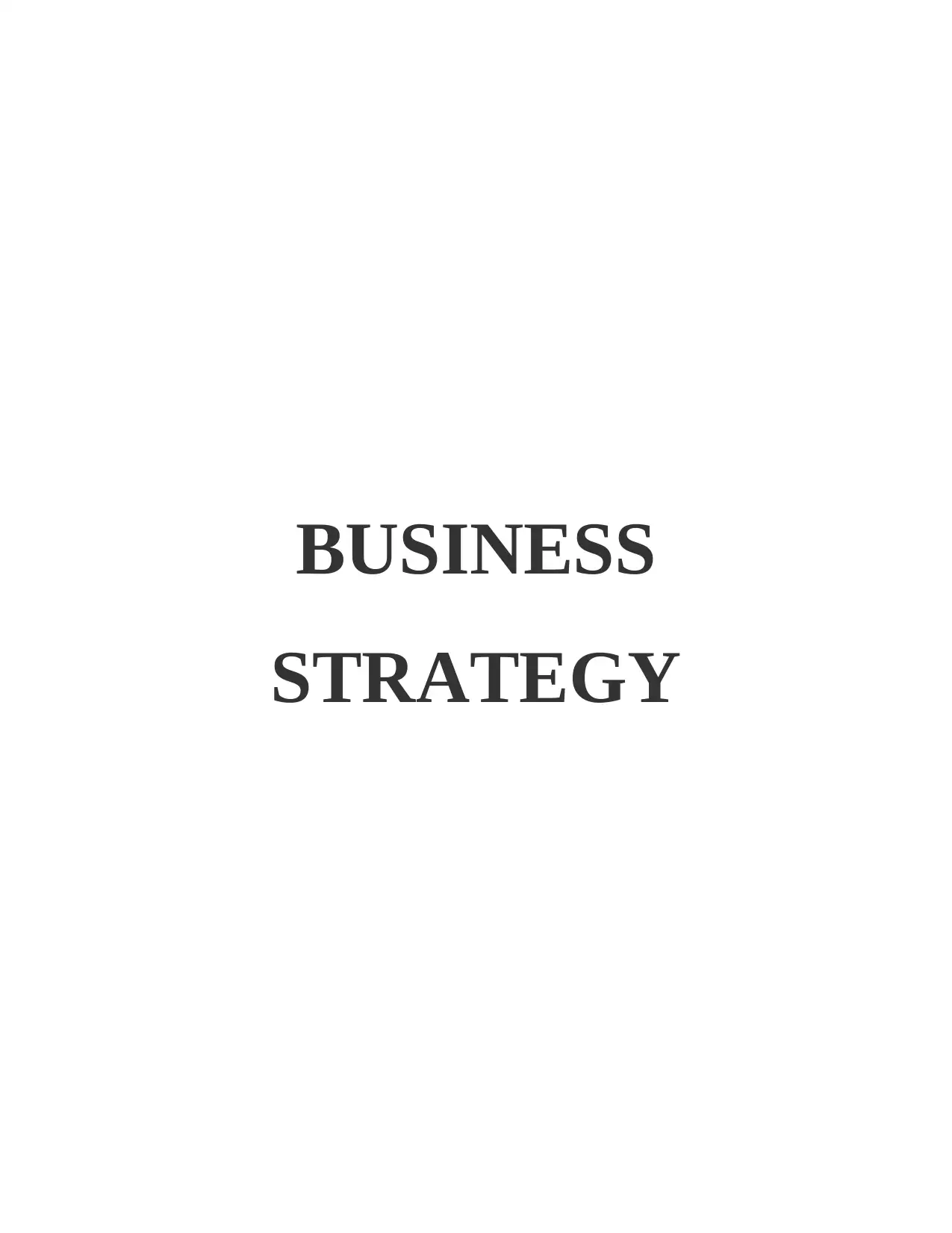
BUSINESS
STRATEGY
STRATEGY
Paraphrase This Document
Need a fresh take? Get an instant paraphrase of this document with our AI Paraphraser

TABLE OF CONTENTS
INTRODUCTION ..........................................................................................................................3
TASK 1............................................................................................................................................3
Analysing the impact and influence of macro environment on Tesco company and its business
strategies......................................................................................................................................3
TASK 2............................................................................................................................................5
a) Analysing strategic capabilities of an entity by using VRIO framework ...............................5
b) Conducting SWOT analysis of an enterprise .........................................................................7
TASK 3............................................................................................................................................8
Porter's five forces model............................................................................................................8
TASK 4............................................................................................................................................9
Strategic direction by using Porter's Generic Strategy................................................................9
REFERENCES..............................................................................................................................10
INTRODUCTION ..........................................................................................................................3
TASK 1............................................................................................................................................3
Analysing the impact and influence of macro environment on Tesco company and its business
strategies......................................................................................................................................3
TASK 2............................................................................................................................................5
a) Analysing strategic capabilities of an entity by using VRIO framework ...............................5
b) Conducting SWOT analysis of an enterprise .........................................................................7
TASK 3............................................................................................................................................8
Porter's five forces model............................................................................................................8
TASK 4............................................................................................................................................9
Strategic direction by using Porter's Generic Strategy................................................................9
REFERENCES..............................................................................................................................10
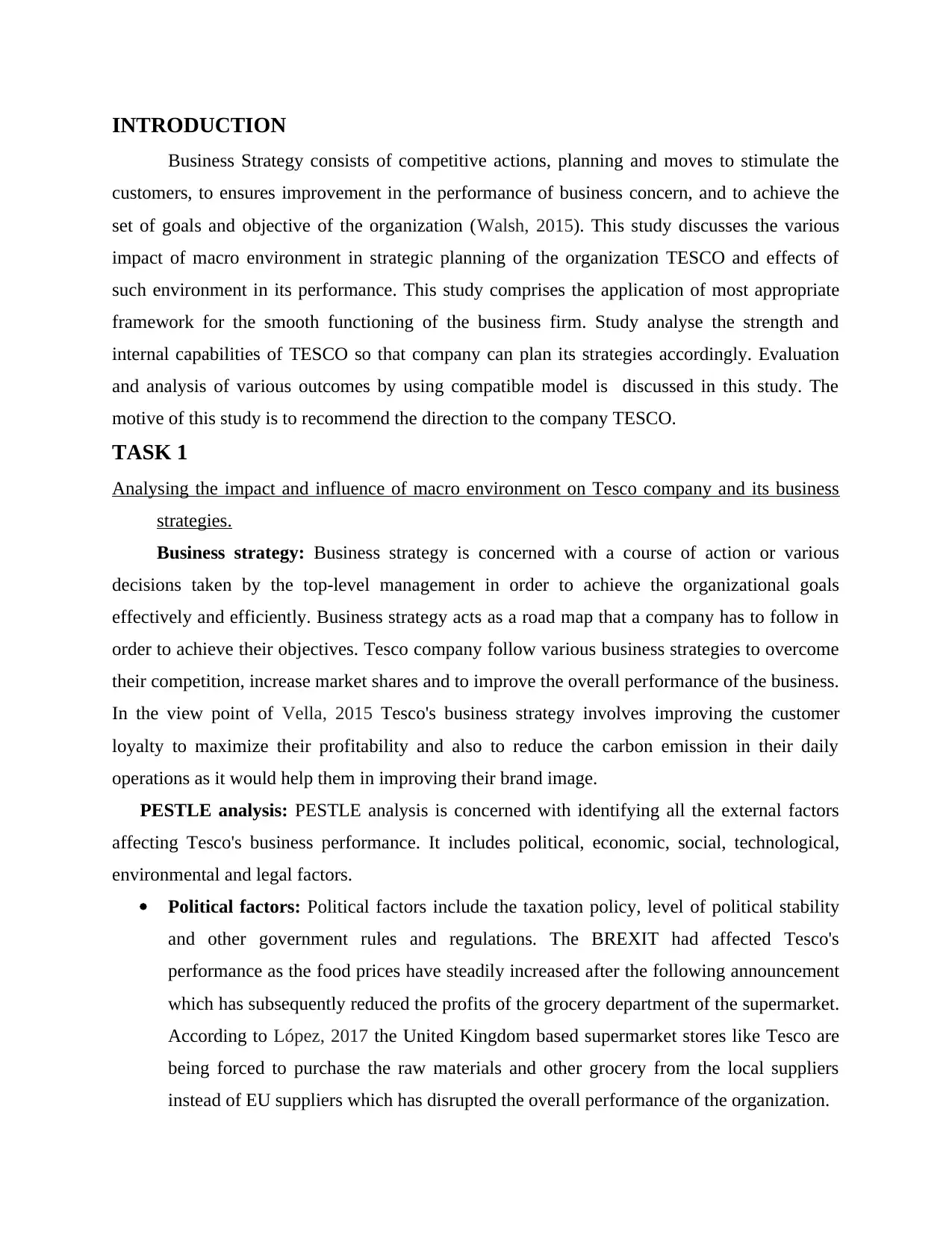
INTRODUCTION
Business Strategy consists of competitive actions, planning and moves to stimulate the
customers, to ensures improvement in the performance of business concern, and to achieve the
set of goals and objective of the organization (Walsh, 2015). This study discusses the various
impact of macro environment in strategic planning of the organization TESCO and effects of
such environment in its performance. This study comprises the application of most appropriate
framework for the smooth functioning of the business firm. Study analyse the strength and
internal capabilities of TESCO so that company can plan its strategies accordingly. Evaluation
and analysis of various outcomes by using compatible model is discussed in this study. The
motive of this study is to recommend the direction to the company TESCO.
TASK 1
Analysing the impact and influence of macro environment on Tesco company and its business
strategies.
Business strategy: Business strategy is concerned with a course of action or various
decisions taken by the top-level management in order to achieve the organizational goals
effectively and efficiently. Business strategy acts as a road map that a company has to follow in
order to achieve their objectives. Tesco company follow various business strategies to overcome
their competition, increase market shares and to improve the overall performance of the business.
In the view point of Vella, 2015 Tesco's business strategy involves improving the customer
loyalty to maximize their profitability and also to reduce the carbon emission in their daily
operations as it would help them in improving their brand image.
PESTLE analysis: PESTLE analysis is concerned with identifying all the external factors
affecting Tesco's business performance. It includes political, economic, social, technological,
environmental and legal factors.
Political factors: Political factors include the taxation policy, level of political stability
and other government rules and regulations. The BREXIT had affected Tesco's
performance as the food prices have steadily increased after the following announcement
which has subsequently reduced the profits of the grocery department of the supermarket.
According to López, 2017 the United Kingdom based supermarket stores like Tesco are
being forced to purchase the raw materials and other grocery from the local suppliers
instead of EU suppliers which has disrupted the overall performance of the organization.
Business Strategy consists of competitive actions, planning and moves to stimulate the
customers, to ensures improvement in the performance of business concern, and to achieve the
set of goals and objective of the organization (Walsh, 2015). This study discusses the various
impact of macro environment in strategic planning of the organization TESCO and effects of
such environment in its performance. This study comprises the application of most appropriate
framework for the smooth functioning of the business firm. Study analyse the strength and
internal capabilities of TESCO so that company can plan its strategies accordingly. Evaluation
and analysis of various outcomes by using compatible model is discussed in this study. The
motive of this study is to recommend the direction to the company TESCO.
TASK 1
Analysing the impact and influence of macro environment on Tesco company and its business
strategies.
Business strategy: Business strategy is concerned with a course of action or various
decisions taken by the top-level management in order to achieve the organizational goals
effectively and efficiently. Business strategy acts as a road map that a company has to follow in
order to achieve their objectives. Tesco company follow various business strategies to overcome
their competition, increase market shares and to improve the overall performance of the business.
In the view point of Vella, 2015 Tesco's business strategy involves improving the customer
loyalty to maximize their profitability and also to reduce the carbon emission in their daily
operations as it would help them in improving their brand image.
PESTLE analysis: PESTLE analysis is concerned with identifying all the external factors
affecting Tesco's business performance. It includes political, economic, social, technological,
environmental and legal factors.
Political factors: Political factors include the taxation policy, level of political stability
and other government rules and regulations. The BREXIT had affected Tesco's
performance as the food prices have steadily increased after the following announcement
which has subsequently reduced the profits of the grocery department of the supermarket.
According to López, 2017 the United Kingdom based supermarket stores like Tesco are
being forced to purchase the raw materials and other grocery from the local suppliers
instead of EU suppliers which has disrupted the overall performance of the organization.
⊘ This is a preview!⊘
Do you want full access?
Subscribe today to unlock all pages.

Trusted by 1+ million students worldwide
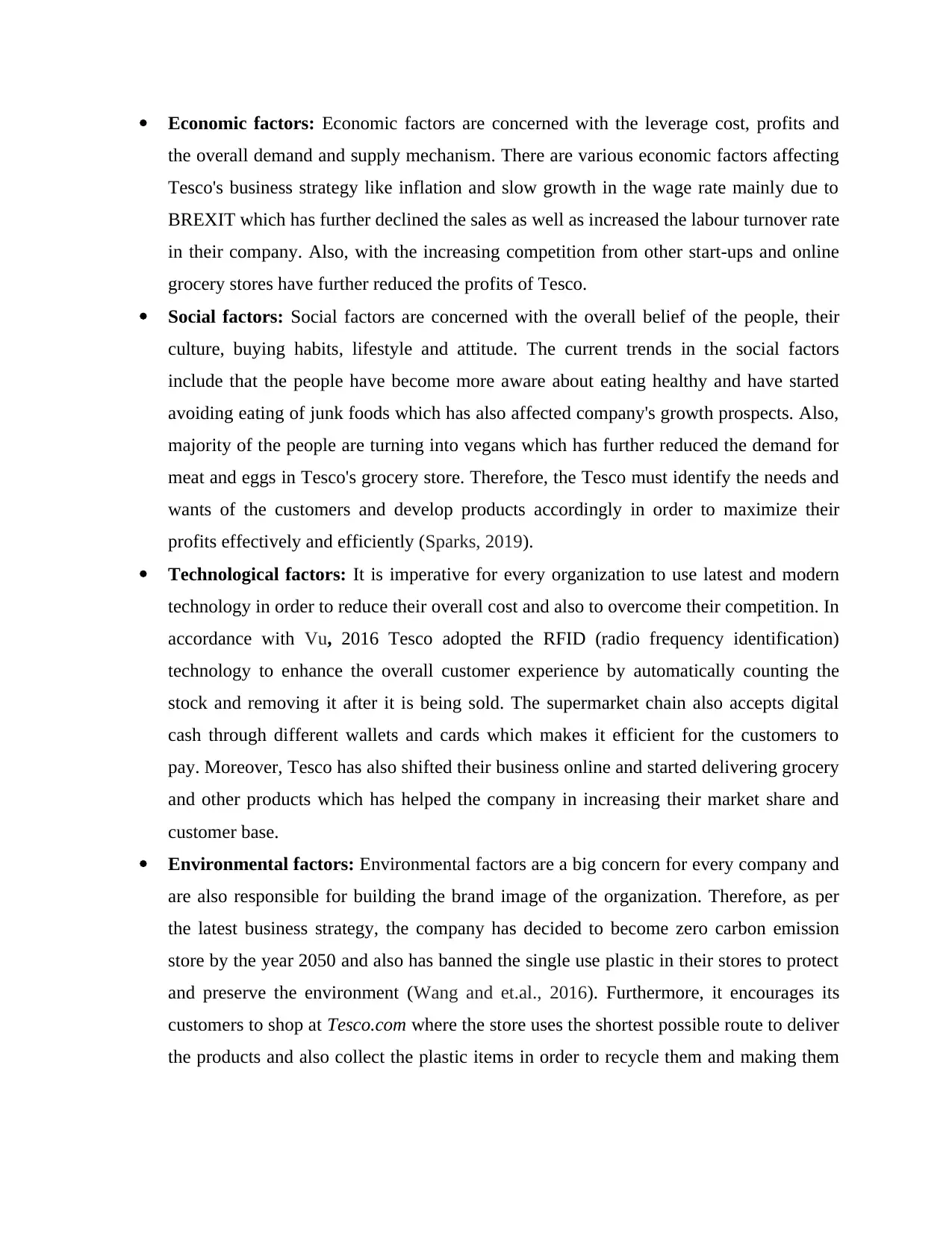
Economic factors: Economic factors are concerned with the leverage cost, profits and
the overall demand and supply mechanism. There are various economic factors affecting
Tesco's business strategy like inflation and slow growth in the wage rate mainly due to
BREXIT which has further declined the sales as well as increased the labour turnover rate
in their company. Also, with the increasing competition from other start-ups and online
grocery stores have further reduced the profits of Tesco.
Social factors: Social factors are concerned with the overall belief of the people, their
culture, buying habits, lifestyle and attitude. The current trends in the social factors
include that the people have become more aware about eating healthy and have started
avoiding eating of junk foods which has also affected company's growth prospects. Also,
majority of the people are turning into vegans which has further reduced the demand for
meat and eggs in Tesco's grocery store. Therefore, the Tesco must identify the needs and
wants of the customers and develop products accordingly in order to maximize their
profits effectively and efficiently (Sparks, 2019).
Technological factors: It is imperative for every organization to use latest and modern
technology in order to reduce their overall cost and also to overcome their competition. In
accordance with Vu, 2016 Tesco adopted the RFID (radio frequency identification)
technology to enhance the overall customer experience by automatically counting the
stock and removing it after it is being sold. The supermarket chain also accepts digital
cash through different wallets and cards which makes it efficient for the customers to
pay. Moreover, Tesco has also shifted their business online and started delivering grocery
and other products which has helped the company in increasing their market share and
customer base.
Environmental factors: Environmental factors are a big concern for every company and
are also responsible for building the brand image of the organization. Therefore, as per
the latest business strategy, the company has decided to become zero carbon emission
store by the year 2050 and also has banned the single use plastic in their stores to protect
and preserve the environment (Wang and et.al., 2016). Furthermore, it encourages its
customers to shop at Tesco.com where the store uses the shortest possible route to deliver
the products and also collect the plastic items in order to recycle them and making them
the overall demand and supply mechanism. There are various economic factors affecting
Tesco's business strategy like inflation and slow growth in the wage rate mainly due to
BREXIT which has further declined the sales as well as increased the labour turnover rate
in their company. Also, with the increasing competition from other start-ups and online
grocery stores have further reduced the profits of Tesco.
Social factors: Social factors are concerned with the overall belief of the people, their
culture, buying habits, lifestyle and attitude. The current trends in the social factors
include that the people have become more aware about eating healthy and have started
avoiding eating of junk foods which has also affected company's growth prospects. Also,
majority of the people are turning into vegans which has further reduced the demand for
meat and eggs in Tesco's grocery store. Therefore, the Tesco must identify the needs and
wants of the customers and develop products accordingly in order to maximize their
profits effectively and efficiently (Sparks, 2019).
Technological factors: It is imperative for every organization to use latest and modern
technology in order to reduce their overall cost and also to overcome their competition. In
accordance with Vu, 2016 Tesco adopted the RFID (radio frequency identification)
technology to enhance the overall customer experience by automatically counting the
stock and removing it after it is being sold. The supermarket chain also accepts digital
cash through different wallets and cards which makes it efficient for the customers to
pay. Moreover, Tesco has also shifted their business online and started delivering grocery
and other products which has helped the company in increasing their market share and
customer base.
Environmental factors: Environmental factors are a big concern for every company and
are also responsible for building the brand image of the organization. Therefore, as per
the latest business strategy, the company has decided to become zero carbon emission
store by the year 2050 and also has banned the single use plastic in their stores to protect
and preserve the environment (Wang and et.al., 2016). Furthermore, it encourages its
customers to shop at Tesco.com where the store uses the shortest possible route to deliver
the products and also collect the plastic items in order to recycle them and making them
Paraphrase This Document
Need a fresh take? Get an instant paraphrase of this document with our AI Paraphraser
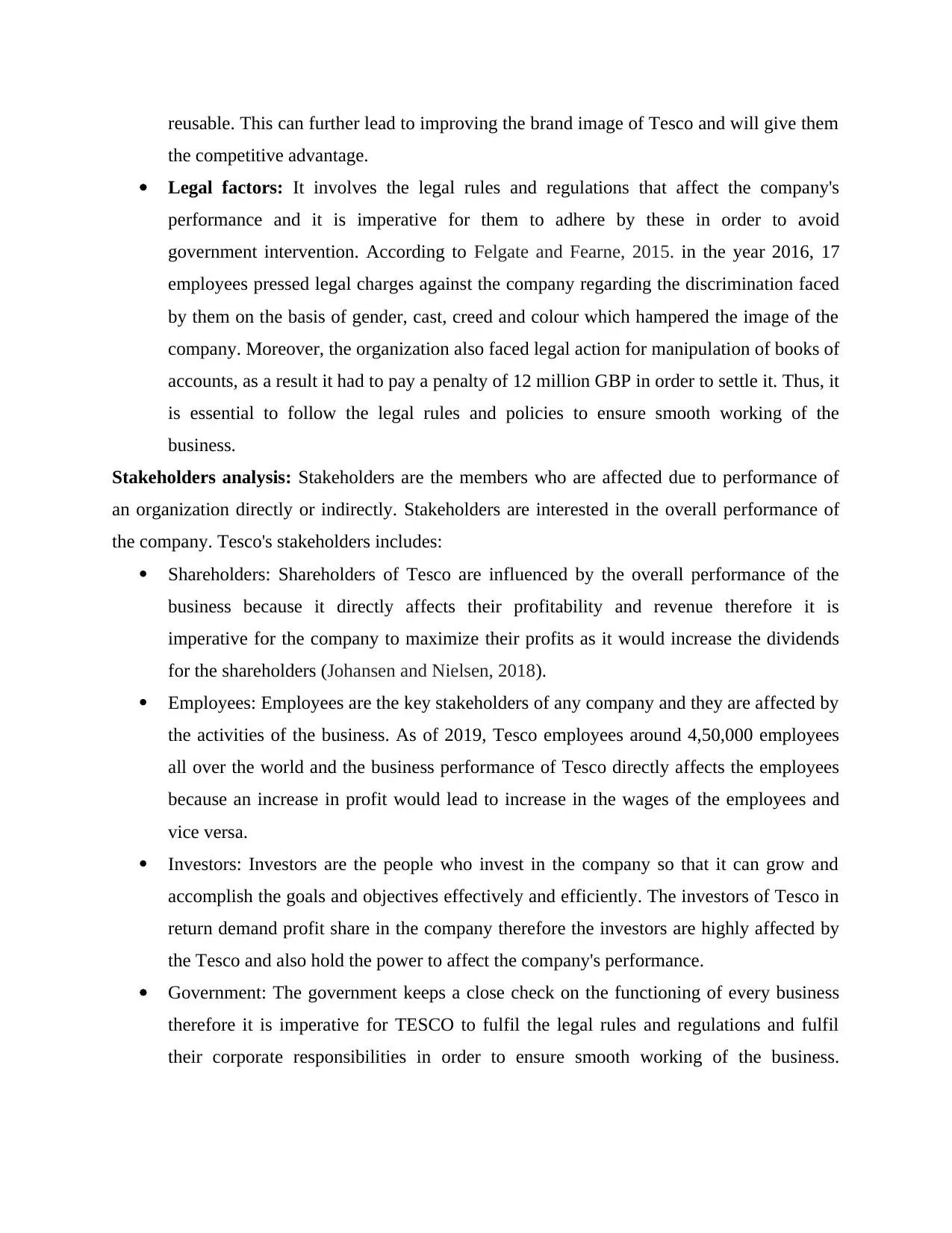
reusable. This can further lead to improving the brand image of Tesco and will give them
the competitive advantage.
Legal factors: It involves the legal rules and regulations that affect the company's
performance and it is imperative for them to adhere by these in order to avoid
government intervention. According to Felgate and Fearne, 2015. in the year 2016, 17
employees pressed legal charges against the company regarding the discrimination faced
by them on the basis of gender, cast, creed and colour which hampered the image of the
company. Moreover, the organization also faced legal action for manipulation of books of
accounts, as a result it had to pay a penalty of 12 million GBP in order to settle it. Thus, it
is essential to follow the legal rules and policies to ensure smooth working of the
business.
Stakeholders analysis: Stakeholders are the members who are affected due to performance of
an organization directly or indirectly. Stakeholders are interested in the overall performance of
the company. Tesco's stakeholders includes:
Shareholders: Shareholders of Tesco are influenced by the overall performance of the
business because it directly affects their profitability and revenue therefore it is
imperative for the company to maximize their profits as it would increase the dividends
for the shareholders (Johansen and Nielsen, 2018).
Employees: Employees are the key stakeholders of any company and they are affected by
the activities of the business. As of 2019, Tesco employees around 4,50,000 employees
all over the world and the business performance of Tesco directly affects the employees
because an increase in profit would lead to increase in the wages of the employees and
vice versa.
Investors: Investors are the people who invest in the company so that it can grow and
accomplish the goals and objectives effectively and efficiently. The investors of Tesco in
return demand profit share in the company therefore the investors are highly affected by
the Tesco and also hold the power to affect the company's performance.
Government: The government keeps a close check on the functioning of every business
therefore it is imperative for TESCO to fulfil the legal rules and regulations and fulfil
their corporate responsibilities in order to ensure smooth working of the business.
the competitive advantage.
Legal factors: It involves the legal rules and regulations that affect the company's
performance and it is imperative for them to adhere by these in order to avoid
government intervention. According to Felgate and Fearne, 2015. in the year 2016, 17
employees pressed legal charges against the company regarding the discrimination faced
by them on the basis of gender, cast, creed and colour which hampered the image of the
company. Moreover, the organization also faced legal action for manipulation of books of
accounts, as a result it had to pay a penalty of 12 million GBP in order to settle it. Thus, it
is essential to follow the legal rules and policies to ensure smooth working of the
business.
Stakeholders analysis: Stakeholders are the members who are affected due to performance of
an organization directly or indirectly. Stakeholders are interested in the overall performance of
the company. Tesco's stakeholders includes:
Shareholders: Shareholders of Tesco are influenced by the overall performance of the
business because it directly affects their profitability and revenue therefore it is
imperative for the company to maximize their profits as it would increase the dividends
for the shareholders (Johansen and Nielsen, 2018).
Employees: Employees are the key stakeholders of any company and they are affected by
the activities of the business. As of 2019, Tesco employees around 4,50,000 employees
all over the world and the business performance of Tesco directly affects the employees
because an increase in profit would lead to increase in the wages of the employees and
vice versa.
Investors: Investors are the people who invest in the company so that it can grow and
accomplish the goals and objectives effectively and efficiently. The investors of Tesco in
return demand profit share in the company therefore the investors are highly affected by
the Tesco and also hold the power to affect the company's performance.
Government: The government keeps a close check on the functioning of every business
therefore it is imperative for TESCO to fulfil the legal rules and regulations and fulfil
their corporate responsibilities in order to ensure smooth working of the business.
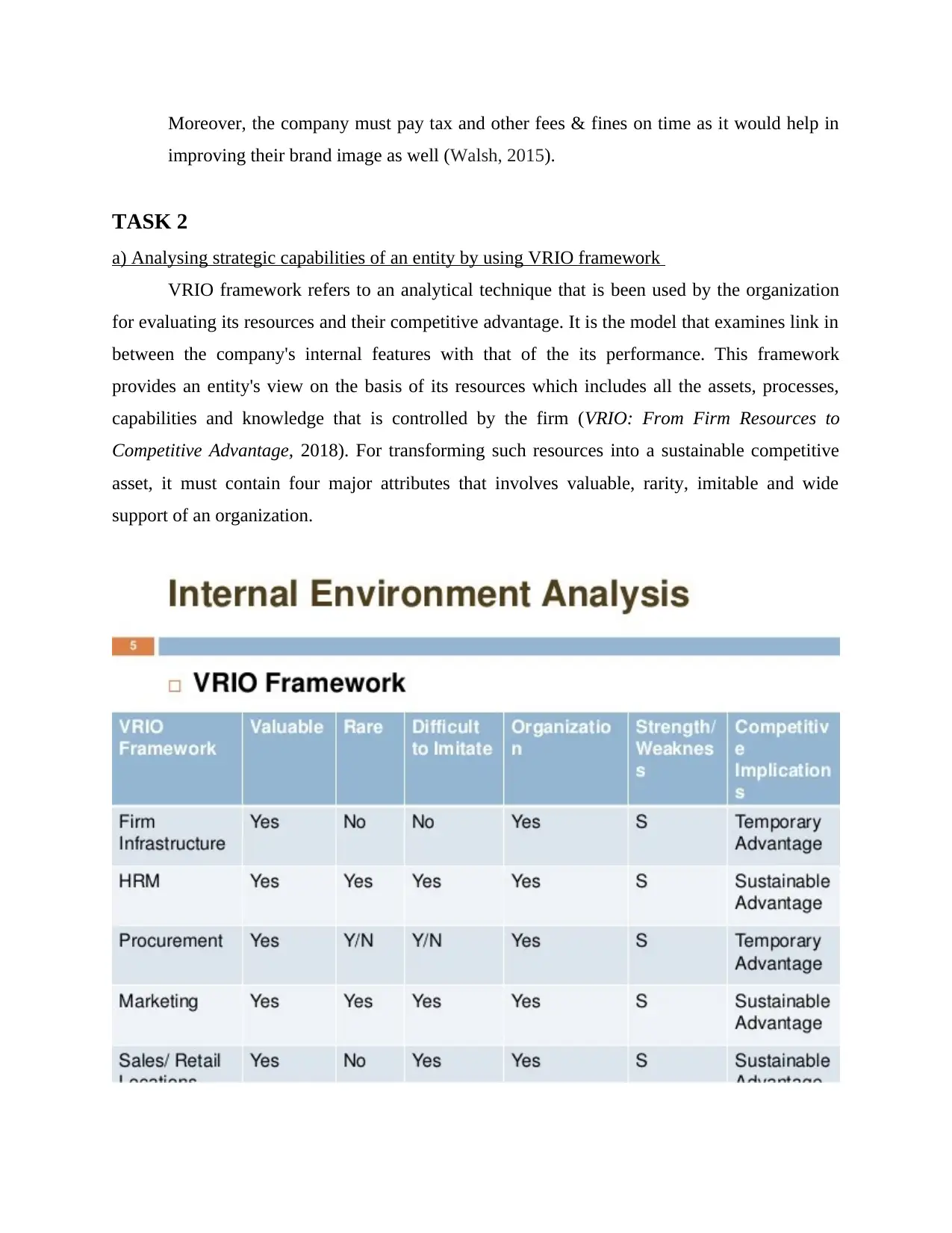
Moreover, the company must pay tax and other fees & fines on time as it would help in
improving their brand image as well (Walsh, 2015).
TASK 2
a) Analysing strategic capabilities of an entity by using VRIO framework
VRIO framework refers to an analytical technique that is been used by the organization
for evaluating its resources and their competitive advantage. It is the model that examines link in
between the company's internal features with that of the its performance. This framework
provides an entity's view on the basis of its resources which includes all the assets, processes,
capabilities and knowledge that is controlled by the firm (VRIO: From Firm Resources to
Competitive Advantage, 2018). For transforming such resources into a sustainable competitive
asset, it must contain four major attributes that involves valuable, rarity, imitable and wide
support of an organization.
improving their brand image as well (Walsh, 2015).
TASK 2
a) Analysing strategic capabilities of an entity by using VRIO framework
VRIO framework refers to an analytical technique that is been used by the organization
for evaluating its resources and their competitive advantage. It is the model that examines link in
between the company's internal features with that of the its performance. This framework
provides an entity's view on the basis of its resources which includes all the assets, processes,
capabilities and knowledge that is controlled by the firm (VRIO: From Firm Resources to
Competitive Advantage, 2018). For transforming such resources into a sustainable competitive
asset, it must contain four major attributes that involves valuable, rarity, imitable and wide
support of an organization.
⊘ This is a preview!⊘
Do you want full access?
Subscribe today to unlock all pages.

Trusted by 1+ million students worldwide

Valuable- Tesco is having the well-known presence across the world that in turn counted
as a crucial or most valuable asset for the firm in order to increase their market share, sales and
the customer base. It is considered as the great medium for gaining more and more revenues
from the existing and the new customers (Akter and et.al., 2016). The resources of Tesco such as
human resource and infrastructure are stated as valuable as it helps an organization in executing
competitive strategies which results in developing the effectiveness and efficiency through
exploiting opportunities and mitigating threats.
Rare- It indicates that the resources of the company must be founded as rare which that it
must be acquired only by few companies. In other words, an enterprise must possess some
valuable resources which are unique or which the other players in an industry are not having and
other companies must not the have the capability of exploiting the resources in same manner. For
example- Tesco attained competitive advantage in development of its retail business by
facilitating high quality product at low price with experienced customer service that leads the
firm towards higher profitability.
Inimitable- This factor of the model represents that the resources of the company must be
such that they are costly and hard to imitate or substituted. This is because valuable and rarity of
the resources only helps an entity to engage in such strategies which the other firms could not
pursue but it does guarantees for gaining a competitive advantage in the long run. It might give
focal enterprises a first mover benefit but the rivalry will probably try for imitating such kind of
resources. For instance- Core competencies of Tesco indicates its ability in creating the chain in
the activities of an organization by combining the resources and the capabilities that are strong
enough for locking out the imitators.
Organized- It highlights that the resources of the firm could not create any competitive
advantage unless the company is not organized in an adequate way to exploit its resources and in
capturing value for its resources. Therefore, the focal company requires capability to assemble
and coordinate its resources in an effective way. For example- Tesco presents a customer
friendly environment within its business so that workers perform their task to their best potential
and provides support to company in achieving its goals optimally.
b) Conducting SWOT analysis of an enterprise
Strengths- Tesco is considered as the leading retailer and called as the number 1
supermarket within the UK as its sales and revenue are higher than its competitors in the Great
as a crucial or most valuable asset for the firm in order to increase their market share, sales and
the customer base. It is considered as the great medium for gaining more and more revenues
from the existing and the new customers (Akter and et.al., 2016). The resources of Tesco such as
human resource and infrastructure are stated as valuable as it helps an organization in executing
competitive strategies which results in developing the effectiveness and efficiency through
exploiting opportunities and mitigating threats.
Rare- It indicates that the resources of the company must be founded as rare which that it
must be acquired only by few companies. In other words, an enterprise must possess some
valuable resources which are unique or which the other players in an industry are not having and
other companies must not the have the capability of exploiting the resources in same manner. For
example- Tesco attained competitive advantage in development of its retail business by
facilitating high quality product at low price with experienced customer service that leads the
firm towards higher profitability.
Inimitable- This factor of the model represents that the resources of the company must be
such that they are costly and hard to imitate or substituted. This is because valuable and rarity of
the resources only helps an entity to engage in such strategies which the other firms could not
pursue but it does guarantees for gaining a competitive advantage in the long run. It might give
focal enterprises a first mover benefit but the rivalry will probably try for imitating such kind of
resources. For instance- Core competencies of Tesco indicates its ability in creating the chain in
the activities of an organization by combining the resources and the capabilities that are strong
enough for locking out the imitators.
Organized- It highlights that the resources of the firm could not create any competitive
advantage unless the company is not organized in an adequate way to exploit its resources and in
capturing value for its resources. Therefore, the focal company requires capability to assemble
and coordinate its resources in an effective way. For example- Tesco presents a customer
friendly environment within its business so that workers perform their task to their best potential
and provides support to company in achieving its goals optimally.
b) Conducting SWOT analysis of an enterprise
Strengths- Tesco is considered as the leading retailer and called as the number 1
supermarket within the UK as its sales and revenue are higher than its competitors in the Great
Paraphrase This Document
Need a fresh take? Get an instant paraphrase of this document with our AI Paraphraser

Britain (Fatricia, 2017). The market share of Tesco is larger and wide which is its major strength
resulted as 4% and due to this it dominates the entire retail market of the Great Britain. Tesco is
having a globally diversified business in more than 6800 stores within 14 countries. It provides a
wide range of products with diversified market which resulted as quite successful in creating a
well-known brand at a global level. Tesco is being known as the largest employer in the entire
Europe as it offers for more than 743K as the job opportunities for the employees worldwide.
Tesco makes use of superior the technology in the best possible manner in order to enhance the
shopping experience of the customers. It had introduced new system called as RFID for counting
the product in an automatic way. The supply chain network of Tesco is efficient as it incurs the
reduced cost and thrives for developing the policies for managing the waste efficiently. This in
turn depicts that Tesco bears profitable relationship with their suppliers.
Weaknesses- Tesco has resulted failed operations within its US and Japan segment in the
year 2012 and such a failed export operation forces an enterprise in closing its stores in Japan
and US, thus this in turn causes a huge failure loss to the company. Financial profits of Tesco are
profoundly affected because of its higher debts and the credit card facility. Although Tesco is
being counted as the price leader in a UK market but its low cost policy could lead the firm in
attaining lower profit margins. Tesco faced a poor performance in particular markets which
clearly means that the company had not carried out the appropriate market research prior to
entering for opening its few stores and grocery outlets in specific countries.
Opportunities- Developing a strategic alliance with its competitors and other brands
creates an excellent opportunity for the firm. It will assist Tesco in offering more products and in
attracting the larger customers (Halil and et.al., 2016). Tesco could avail an opportunity by
growing and upgrading its business on online platforms along with the home delivery services.
Company must seek for expanding its business in the emerging countries such as Turkey,
Indonesia etc. which could be a profitable opportunity for an entity.
Threats- Tesco faced many controversies on social media in the year 2017 as it had
launched its Christmas ad. People boycotted Tesco store claiming that the company performed
disrespectful act against the Christian faith (SWOT analysis of Tesco, 2019). Tesco faces a high
competition threat with the supermarket giants such as Walmart, Aldi and Carrefour as it will
affect the market position of the company.
resulted as 4% and due to this it dominates the entire retail market of the Great Britain. Tesco is
having a globally diversified business in more than 6800 stores within 14 countries. It provides a
wide range of products with diversified market which resulted as quite successful in creating a
well-known brand at a global level. Tesco is being known as the largest employer in the entire
Europe as it offers for more than 743K as the job opportunities for the employees worldwide.
Tesco makes use of superior the technology in the best possible manner in order to enhance the
shopping experience of the customers. It had introduced new system called as RFID for counting
the product in an automatic way. The supply chain network of Tesco is efficient as it incurs the
reduced cost and thrives for developing the policies for managing the waste efficiently. This in
turn depicts that Tesco bears profitable relationship with their suppliers.
Weaknesses- Tesco has resulted failed operations within its US and Japan segment in the
year 2012 and such a failed export operation forces an enterprise in closing its stores in Japan
and US, thus this in turn causes a huge failure loss to the company. Financial profits of Tesco are
profoundly affected because of its higher debts and the credit card facility. Although Tesco is
being counted as the price leader in a UK market but its low cost policy could lead the firm in
attaining lower profit margins. Tesco faced a poor performance in particular markets which
clearly means that the company had not carried out the appropriate market research prior to
entering for opening its few stores and grocery outlets in specific countries.
Opportunities- Developing a strategic alliance with its competitors and other brands
creates an excellent opportunity for the firm. It will assist Tesco in offering more products and in
attracting the larger customers (Halil and et.al., 2016). Tesco could avail an opportunity by
growing and upgrading its business on online platforms along with the home delivery services.
Company must seek for expanding its business in the emerging countries such as Turkey,
Indonesia etc. which could be a profitable opportunity for an entity.
Threats- Tesco faced many controversies on social media in the year 2017 as it had
launched its Christmas ad. People boycotted Tesco store claiming that the company performed
disrespectful act against the Christian faith (SWOT analysis of Tesco, 2019). Tesco faces a high
competition threat with the supermarket giants such as Walmart, Aldi and Carrefour as it will
affect the market position of the company.
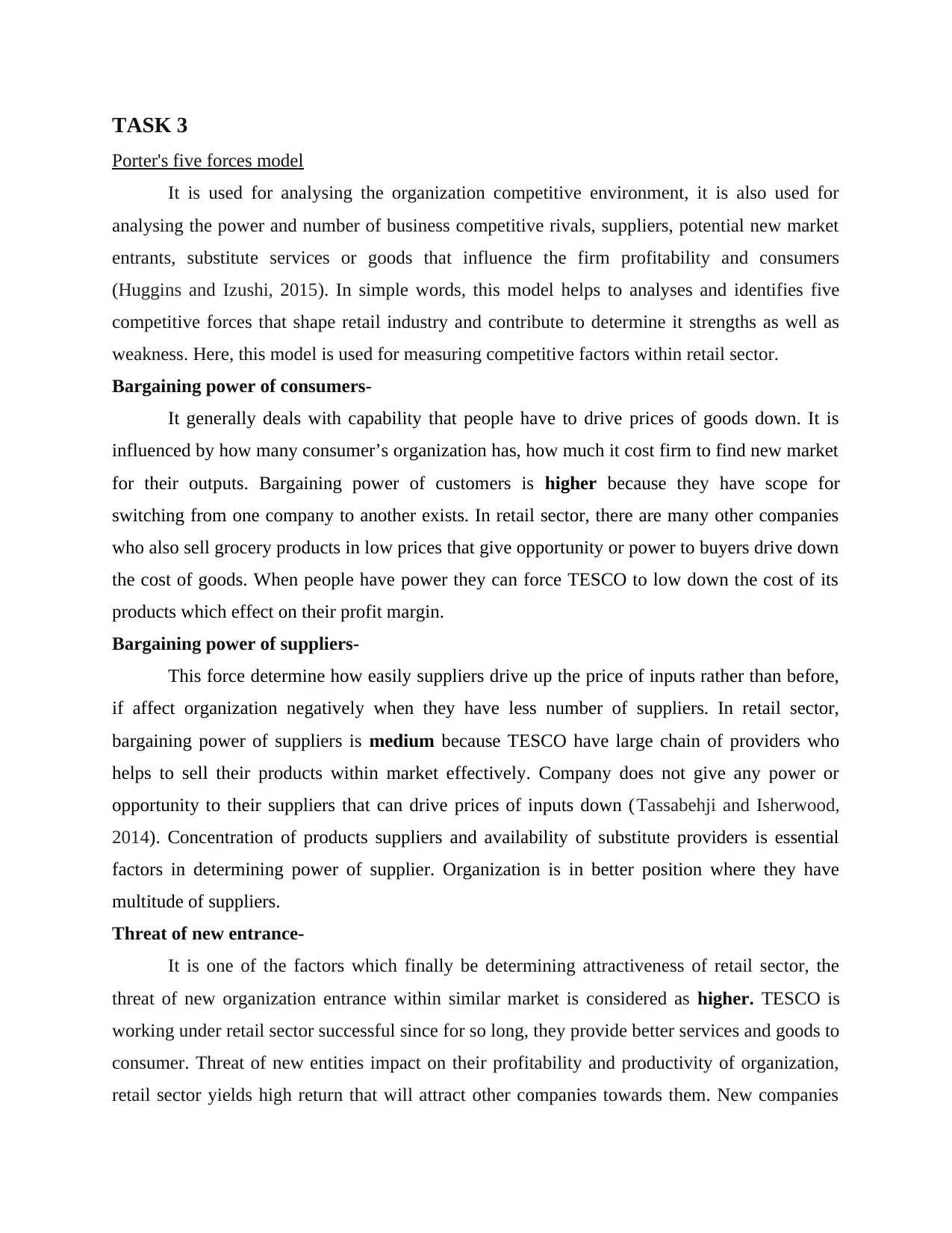
TASK 3
Porter's five forces model
It is used for analysing the organization competitive environment, it is also used for
analysing the power and number of business competitive rivals, suppliers, potential new market
entrants, substitute services or goods that influence the firm profitability and consumers
(Huggins and Izushi, 2015). In simple words, this model helps to analyses and identifies five
competitive forces that shape retail industry and contribute to determine it strengths as well as
weakness. Here, this model is used for measuring competitive factors within retail sector.
Bargaining power of consumers-
It generally deals with capability that people have to drive prices of goods down. It is
influenced by how many consumer’s organization has, how much it cost firm to find new market
for their outputs. Bargaining power of customers is higher because they have scope for
switching from one company to another exists. In retail sector, there are many other companies
who also sell grocery products in low prices that give opportunity or power to buyers drive down
the cost of goods. When people have power they can force TESCO to low down the cost of its
products which effect on their profit margin.
Bargaining power of suppliers-
This force determine how easily suppliers drive up the price of inputs rather than before,
if affect organization negatively when they have less number of suppliers. In retail sector,
bargaining power of suppliers is medium because TESCO have large chain of providers who
helps to sell their products within market effectively. Company does not give any power or
opportunity to their suppliers that can drive prices of inputs down (Tassabehji and Isherwood,
2014). Concentration of products suppliers and availability of substitute providers is essential
factors in determining power of supplier. Organization is in better position where they have
multitude of suppliers.
Threat of new entrance-
It is one of the factors which finally be determining attractiveness of retail sector, the
threat of new organization entrance within similar market is considered as higher. TESCO is
working under retail sector successful since for so long, they provide better services and goods to
consumer. Threat of new entities impact on their profitability and productivity of organization,
retail sector yields high return that will attract other companies towards them. New companies
Porter's five forces model
It is used for analysing the organization competitive environment, it is also used for
analysing the power and number of business competitive rivals, suppliers, potential new market
entrants, substitute services or goods that influence the firm profitability and consumers
(Huggins and Izushi, 2015). In simple words, this model helps to analyses and identifies five
competitive forces that shape retail industry and contribute to determine it strengths as well as
weakness. Here, this model is used for measuring competitive factors within retail sector.
Bargaining power of consumers-
It generally deals with capability that people have to drive prices of goods down. It is
influenced by how many consumer’s organization has, how much it cost firm to find new market
for their outputs. Bargaining power of customers is higher because they have scope for
switching from one company to another exists. In retail sector, there are many other companies
who also sell grocery products in low prices that give opportunity or power to buyers drive down
the cost of goods. When people have power they can force TESCO to low down the cost of its
products which effect on their profit margin.
Bargaining power of suppliers-
This force determine how easily suppliers drive up the price of inputs rather than before,
if affect organization negatively when they have less number of suppliers. In retail sector,
bargaining power of suppliers is medium because TESCO have large chain of providers who
helps to sell their products within market effectively. Company does not give any power or
opportunity to their suppliers that can drive prices of inputs down (Tassabehji and Isherwood,
2014). Concentration of products suppliers and availability of substitute providers is essential
factors in determining power of supplier. Organization is in better position where they have
multitude of suppliers.
Threat of new entrance-
It is one of the factors which finally be determining attractiveness of retail sector, the
threat of new organization entrance within similar market is considered as higher. TESCO is
working under retail sector successful since for so long, they provide better services and goods to
consumer. Threat of new entities impact on their profitability and productivity of organization,
retail sector yields high return that will attract other companies towards them. New companies
⊘ This is a preview!⊘
Do you want full access?
Subscribe today to unlock all pages.

Trusted by 1+ million students worldwide
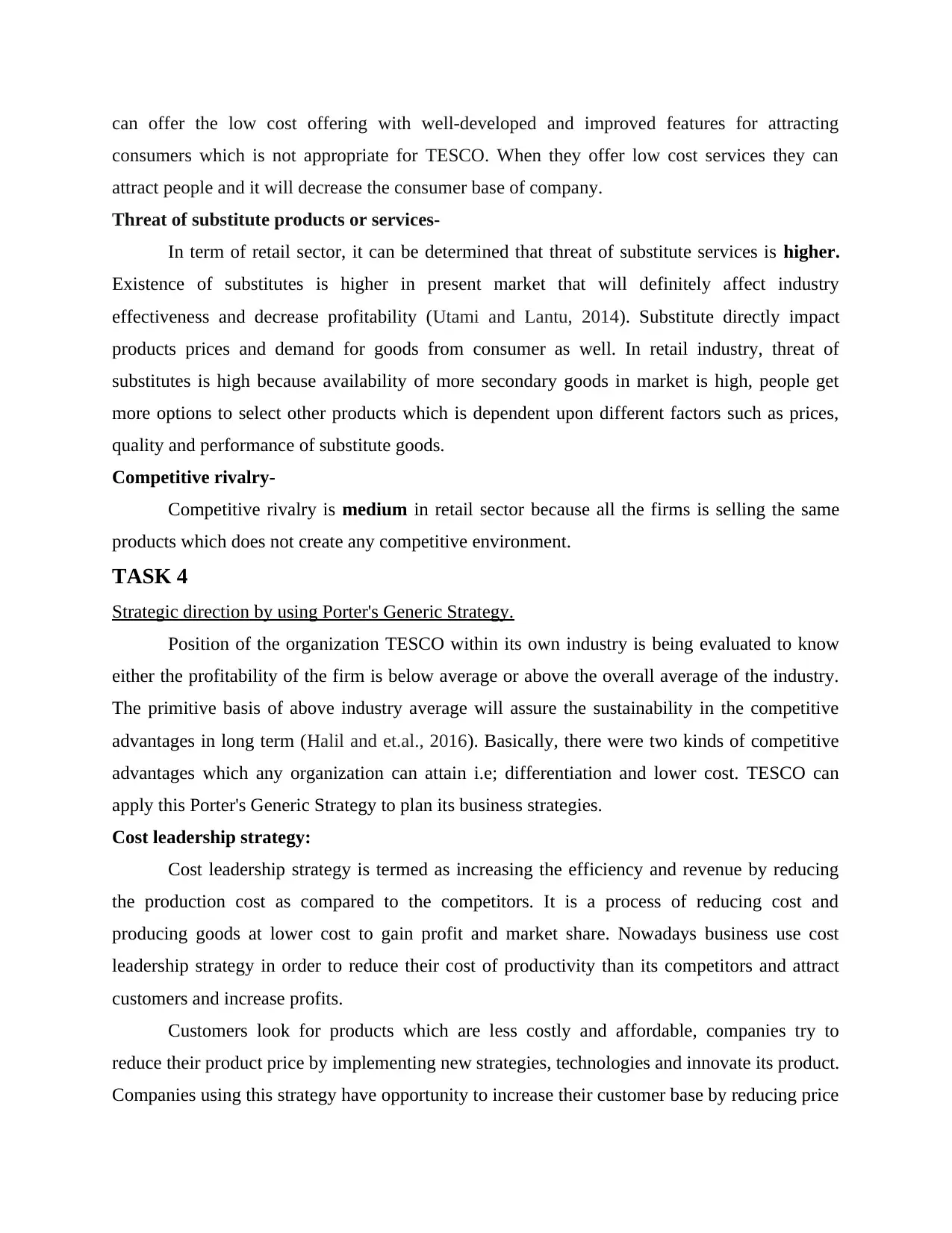
can offer the low cost offering with well-developed and improved features for attracting
consumers which is not appropriate for TESCO. When they offer low cost services they can
attract people and it will decrease the consumer base of company.
Threat of substitute products or services-
In term of retail sector, it can be determined that threat of substitute services is higher.
Existence of substitutes is higher in present market that will definitely affect industry
effectiveness and decrease profitability (Utami and Lantu, 2014). Substitute directly impact
products prices and demand for goods from consumer as well. In retail industry, threat of
substitutes is high because availability of more secondary goods in market is high, people get
more options to select other products which is dependent upon different factors such as prices,
quality and performance of substitute goods.
Competitive rivalry-
Competitive rivalry is medium in retail sector because all the firms is selling the same
products which does not create any competitive environment.
TASK 4
Strategic direction by using Porter's Generic Strategy.
Position of the organization TESCO within its own industry is being evaluated to know
either the profitability of the firm is below average or above the overall average of the industry.
The primitive basis of above industry average will assure the sustainability in the competitive
advantages in long term (Halil and et.al., 2016). Basically, there were two kinds of competitive
advantages which any organization can attain i.e; differentiation and lower cost. TESCO can
apply this Porter's Generic Strategy to plan its business strategies.
Cost leadership strategy:
Cost leadership strategy is termed as increasing the efficiency and revenue by reducing
the production cost as compared to the competitors. It is a process of reducing cost and
producing goods at lower cost to gain profit and market share. Nowadays business use cost
leadership strategy in order to reduce their cost of productivity than its competitors and attract
customers and increase profits.
Customers look for products which are less costly and affordable, companies try to
reduce their product price by implementing new strategies, technologies and innovate its product.
Companies using this strategy have opportunity to increase their customer base by reducing price
consumers which is not appropriate for TESCO. When they offer low cost services they can
attract people and it will decrease the consumer base of company.
Threat of substitute products or services-
In term of retail sector, it can be determined that threat of substitute services is higher.
Existence of substitutes is higher in present market that will definitely affect industry
effectiveness and decrease profitability (Utami and Lantu, 2014). Substitute directly impact
products prices and demand for goods from consumer as well. In retail industry, threat of
substitutes is high because availability of more secondary goods in market is high, people get
more options to select other products which is dependent upon different factors such as prices,
quality and performance of substitute goods.
Competitive rivalry-
Competitive rivalry is medium in retail sector because all the firms is selling the same
products which does not create any competitive environment.
TASK 4
Strategic direction by using Porter's Generic Strategy.
Position of the organization TESCO within its own industry is being evaluated to know
either the profitability of the firm is below average or above the overall average of the industry.
The primitive basis of above industry average will assure the sustainability in the competitive
advantages in long term (Halil and et.al., 2016). Basically, there were two kinds of competitive
advantages which any organization can attain i.e; differentiation and lower cost. TESCO can
apply this Porter's Generic Strategy to plan its business strategies.
Cost leadership strategy:
Cost leadership strategy is termed as increasing the efficiency and revenue by reducing
the production cost as compared to the competitors. It is a process of reducing cost and
producing goods at lower cost to gain profit and market share. Nowadays business use cost
leadership strategy in order to reduce their cost of productivity than its competitors and attract
customers and increase profits.
Customers look for products which are less costly and affordable, companies try to
reduce their product price by implementing new strategies, technologies and innovate its product.
Companies using this strategy have opportunity to increase their customer base by reducing price
Paraphrase This Document
Need a fresh take? Get an instant paraphrase of this document with our AI Paraphraser
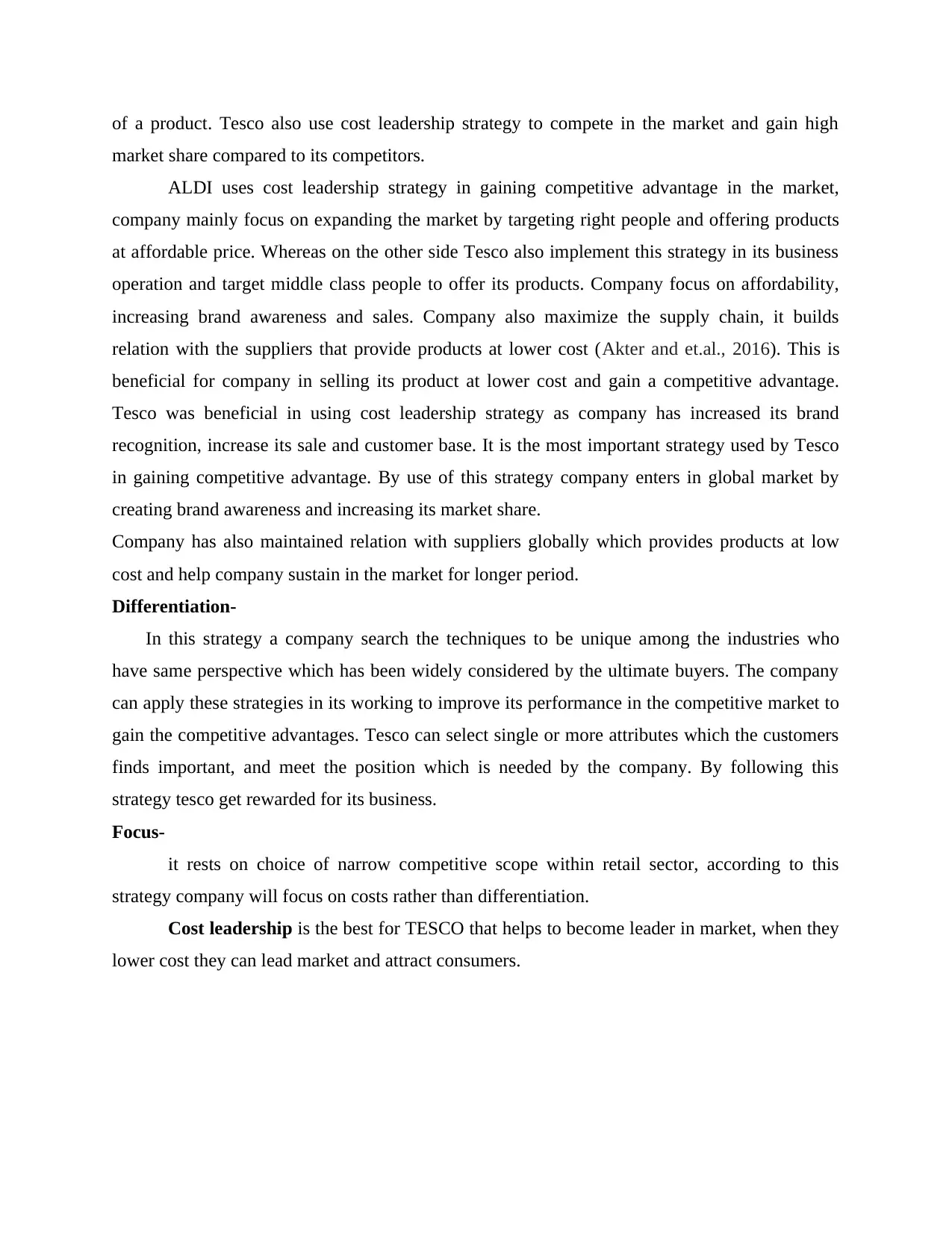
of a product. Tesco also use cost leadership strategy to compete in the market and gain high
market share compared to its competitors.
ALDI uses cost leadership strategy in gaining competitive advantage in the market,
company mainly focus on expanding the market by targeting right people and offering products
at affordable price. Whereas on the other side Tesco also implement this strategy in its business
operation and target middle class people to offer its products. Company focus on affordability,
increasing brand awareness and sales. Company also maximize the supply chain, it builds
relation with the suppliers that provide products at lower cost (Akter and et.al., 2016). This is
beneficial for company in selling its product at lower cost and gain a competitive advantage.
Tesco was beneficial in using cost leadership strategy as company has increased its brand
recognition, increase its sale and customer base. It is the most important strategy used by Tesco
in gaining competitive advantage. By use of this strategy company enters in global market by
creating brand awareness and increasing its market share.
Company has also maintained relation with suppliers globally which provides products at low
cost and help company sustain in the market for longer period.
Differentiation-
In this strategy a company search the techniques to be unique among the industries who
have same perspective which has been widely considered by the ultimate buyers. The company
can apply these strategies in its working to improve its performance in the competitive market to
gain the competitive advantages. Tesco can select single or more attributes which the customers
finds important, and meet the position which is needed by the company. By following this
strategy tesco get rewarded for its business.
Focus-
it rests on choice of narrow competitive scope within retail sector, according to this
strategy company will focus on costs rather than differentiation.
Cost leadership is the best for TESCO that helps to become leader in market, when they
lower cost they can lead market and attract consumers.
market share compared to its competitors.
ALDI uses cost leadership strategy in gaining competitive advantage in the market,
company mainly focus on expanding the market by targeting right people and offering products
at affordable price. Whereas on the other side Tesco also implement this strategy in its business
operation and target middle class people to offer its products. Company focus on affordability,
increasing brand awareness and sales. Company also maximize the supply chain, it builds
relation with the suppliers that provide products at lower cost (Akter and et.al., 2016). This is
beneficial for company in selling its product at lower cost and gain a competitive advantage.
Tesco was beneficial in using cost leadership strategy as company has increased its brand
recognition, increase its sale and customer base. It is the most important strategy used by Tesco
in gaining competitive advantage. By use of this strategy company enters in global market by
creating brand awareness and increasing its market share.
Company has also maintained relation with suppliers globally which provides products at low
cost and help company sustain in the market for longer period.
Differentiation-
In this strategy a company search the techniques to be unique among the industries who
have same perspective which has been widely considered by the ultimate buyers. The company
can apply these strategies in its working to improve its performance in the competitive market to
gain the competitive advantages. Tesco can select single or more attributes which the customers
finds important, and meet the position which is needed by the company. By following this
strategy tesco get rewarded for its business.
Focus-
it rests on choice of narrow competitive scope within retail sector, according to this
strategy company will focus on costs rather than differentiation.
Cost leadership is the best for TESCO that helps to become leader in market, when they
lower cost they can lead market and attract consumers.

CONCLUSION
From the above study it can be concluded that the macro environment imposes its impact
on the organizational strategies. It has been analysed from the study that business strategies get
influenced by the macro environment, and affected positively as well as negatively on the
strategic planning of TESCO. This study analysed that the profitability of the company TESCO
affects the share of its stakeholders and also imposed its impacts on other party such as
employees, investors and government as well. In this study the internal capabilities of TESCO
have been analysed with the help of using VRIO framework, and also the strengths, weaknesses,
opportunities and threat has been analysed. This study also evaluated the competitive forces by
using the model, Porter's Five Forces, by which its advantages and disadvantages has been
analysed for the organization TESCO. In this study the company has been suggested some
strategic direction which is based Porter's Generic Strategy, and it is recommended to follow this
framework for smooth functioning of the organization.
From the above study it can be concluded that the macro environment imposes its impact
on the organizational strategies. It has been analysed from the study that business strategies get
influenced by the macro environment, and affected positively as well as negatively on the
strategic planning of TESCO. This study analysed that the profitability of the company TESCO
affects the share of its stakeholders and also imposed its impacts on other party such as
employees, investors and government as well. In this study the internal capabilities of TESCO
have been analysed with the help of using VRIO framework, and also the strengths, weaknesses,
opportunities and threat has been analysed. This study also evaluated the competitive forces by
using the model, Porter's Five Forces, by which its advantages and disadvantages has been
analysed for the organization TESCO. In this study the company has been suggested some
strategic direction which is based Porter's Generic Strategy, and it is recommended to follow this
framework for smooth functioning of the organization.
⊘ This is a preview!⊘
Do you want full access?
Subscribe today to unlock all pages.

Trusted by 1+ million students worldwide
1 out of 14
Related Documents
Your All-in-One AI-Powered Toolkit for Academic Success.
+13062052269
info@desklib.com
Available 24*7 on WhatsApp / Email
![[object Object]](/_next/static/media/star-bottom.7253800d.svg)
Unlock your academic potential
Copyright © 2020–2025 A2Z Services. All Rights Reserved. Developed and managed by ZUCOL.





